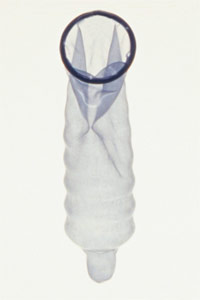
Practice safer sex
- Safer sex
- Take time to talk before having sex
- How to use condoms
- More information on practicing safer sex
Safer sex
Taking simple steps to prevent getting or spreading HIV will pay off both for you and for those you love. The only 100 percent effective way to prevent the spread of HIV through sex is to abstain — to not have sex of any kind. If you do have sex, practice safer sex methods. These are the steps you can take to help prevent HIV infection from sex:
- Abstain from sex. Not having vaginal, anal, or oral sex is the surest way to avoid HIV. If you do decide to have sex, you can reduce your risk of HIV by practicing safer sex.
- Get tested. Be sure you know yours and your partner's HIV status before ever having sex.
- Use condoms. Use them correctly and every time you have sex. Using a male condom for all types of sex can greatly lower your risk of getting HIV during sex. If you or your partner is allergic to latex, use polyurethane condoms. If your partner won't use a male condom, you can use a female condom. It may protect against HIV, but we don't have much evidence that it does, so it is better to use a male condom, which we know has a high rate of preventing HIV infection. Do not use a male and female condom at the same time. They do not work together and can break. "Natural" or "lambskin" condoms don't protect against HIV. Condoms are easy to find, and some places give them out for free. Contact your local health department or a health clinic for information about places in your area that may give away free condoms. For instance, the New York State Health Department offers a cellphone app that can help youth find free condoms in their area.
- Talk with your partner. Learn how to talk with your sexual partner about HIV and using condoms. It's up to you to make sure you are protected. Remember, it's your body!
- Practice monogamy (be faithful to one partner). Being in a sexual relationship with only one partner who is also faithful to you can help protect you.
- Limit your number of sexual partners. Your risk of getting HIV goes up with the number of partners you have. Condoms should be used for any sexual activity with a partner who has HIV. They should also be used with any partner outside of a long-term, faithful sexual relationship.
- Use protection for all kinds of sexual contact. Remember that you don't only get HIV from penile-vaginal sex. Use a condom during oral sex and during anal sex. Dental dams also can be used to help lower your risk as well as your partner's risk of getting HIV during oral-vaginal or oral-anal sex.
- Know that other types of birth control will not protect you from HIV. Other methods of birth control, like birth control pills, shots, implants, or diaphragms, will not protect you from HIV. If you use one of these, be sure to also use a male condom or dental dam correctly every time you have sex.
- Don't use nonoxynol-9 (N-9). Some contraceptives, like condoms, suppositories, foams, and gels contain the spermicide N-9. You shouldn't be using gels, foams, or suppositories to prevent against HIV — these methods only lower chances of pregnancy, not of HIV and other sexually transmitted infections (STIs). N-9 actually makes your risk of HIV infection higher, because it can irritate the vagina, which might make it easier for HIV to get into your body.
- Get screened for STIs. Having an STI, particularly genital herpes, increases your chances of becoming infected with HIV during sex. If your partner has an STI in addition to HIV, that also increases your risk of HIV infection. If you have an STI, you should also get tested for HIV.
- Don't douche. Douching removes some of the normal bacteria in the vagina that protects you from infection. This can increase your risk of getting HIV.
- Don't abuse alcohol or drugs, which are linked to sexual risk-taking. Drinking too much alcohol or using drugs also puts you at risk of sexual assault and possible exposure to HIV.
Take time to talk before having sex
Talking about sex is hard for some people. So, they don't bring up safe sex or STIs with their partners. But keep in mind that it's your body, and it's up to you to protect yourself. Before having sex, talk with your partner about his or her past and present sexual behavior and HIV status, and talk about using condoms and dental dams. Ask if he or she has been tested for HIV or other STIs. Having the talk ahead of time can help you avoid misunderstandings during a moment of passion. Let your partner know that you will not have any type of sex at any time without using a condom or dental dam. If your partner gives an excuse, be ready with a response. Here are some ideas:
| If your partner says: | You say: |
|---|---|
 "Trust me...I don't have any diseases." |
 "It's not about trust. Some people have STIs and don't even know it because they have no symptoms. Using a condom will protect both of us." |
| If your partner says: | You say: |
|---|---|
 "Sex doesn't feel as good with a condom." |
 "Let's try another brand or style." |
| If your partner says: | You say: |
|---|---|
 "Stopping to put on a dental dam spoils the mood." |
 "I can't enjoy sex if it's not safe." |
| If your partner says: | You say: |
|---|---|
 "Let's just do it this one time without a condom." |
 "It only takes one time to get pregnant or get an STI." |
| If your partner says: | You say: |
|---|---|
 "I don't have a condom with me." |
 "That's okay. I do!" |
How to use condoms
Male and female condoms can be used to protect you from HIV. But don't use them both at the same time! If used together, they won't stay in place, and they can tear or become damaged. Read the instructions and practice a few times before using condoms for the first time. Also, follow these guidelines:
Male condom

Male condom
Use male condoms made of latex, or polyurethane if you or your partner is allergic to latex. Use male condoms for vaginal, anal, or oral sex.
- Keep male condoms in a cool, dry place. Don't keep them in your wallet or in your car! This can cause them to break or tear.
- Check the wrapper for tears and for the expiration date, to make sure the condom is not too old to use. Carefully open the wrapper. Don't use your teeth or fingernails. Make sure the condom looks okay to use. Don't use a condom that's gummy, brittle, discolored, or has even a tiny hole.
- Put on the condom as soon as the penis is erect, but before it touches the vagina, mouth, or anus.
- Use lubricants only made with water, such as K-Y jelly. Oil-based lubricants, such as Vaseline, can weaken the condom. The lubricant is put on the outside of the condom. It helps to keep the condom from tearing. Don't use lubricants with the spermicide N-9, which might make it easier for HIV to get into your body.
- After sex, pull out the penis while it is still erect, holding the condom firmly at the base of the penis so it does not slip off.
- Use a new condom if you want to have sex again or in a different way. Do not wash and re-use condoms — they are for one-time use!
Female condom

Female condom
The female condom, known as the FC2, is made of a rubber-like substance that is not latex. This condom is made for vaginal sex only. FC2 has a ring on each end. The inside ring holds the condom in place inside the vagina. The outer ring stays outside the vagina so it covers the labia. Some research suggests that the female condom is effective at preventing HIV. It is not yet known whether it is as effective as the male condom. The male condom is still considered best for preventing HIV. Use female condoms for vaginal sex if your partner won't use a male condom. Remember: Don't use a male condom and a female condom at the same time. They could break.
To see how to use the FC2 female condom, watch this illustrated video from the manufacturer. You can also follow these steps:
- Check the wrapper for tears and to make sure the condom is not too old to use. Open the wrapper carefully. Don't use your teeth or fingernails. Make sure the condom looks OK to use. The condom will be moist and may be slippery.
- Put the condom into the vagina up to eight hours before having sex, but before the penis touches the vagina. The condom cannot disappear inside your body.
- To insert the FC2, squeeze the inner ring with the thumb and middle finger and insert it into the vagina like a tampon. Then, use the index finger to push the inner ring as far up as it will go, without twisting the condom. There should be about an inch of condom outside your vagina to allow for the condom to expand during sex.
- FC2 comes pre-lubricated. But it is okay to use water or oil-based lubricants too. The lubricant is put on the inside and outside of the condom.
- During sex, make sure the outer ring of the FC2 isn't pushed into the vagina.
- After sex, hold the condom in place while your partner withdraws his penis. Remove the condom before standing up. Grasp the outside ring and twist the condom to trap in fluid and gently remove. Or, you can hold the condom tight around your partner's penis and he can pull out his penis and the condom at the same time, being careful not to spill any fluid out of the condom.
- Use a new condom if you want to have sex again.
More information on practicing safer sex
Explore other publications and websites
-
Addressing HIV, Other Sexually Transmitted Diseases, and Pregnancy Prevention — This publication discusses how the Centers for Disease Control and Prevention's Division of Adolescent and School Health is working to prevent unintended pregnancy, HIV, and other sexually transmitted infections among youth.
http://www.cdc.gov/HealthyYouth/sexualbehaviors/pdf/Addressing_HIV.pdf
-
HIV Transmission — This Web page answers common questions about how HIV can be passed from one person to another.
http://www.cdc.gov/hiv/resources/qa/transmission.htm
-
How to Use a Condom (Copyright © American Social Health Association) — This website provides a list of "do's and don'ts" about how to use a male condom. The site also features an animation, which shows the proper way to put on and remove a condom.
http://www.ashastd.org/condom/condom_overview.cfm
-
Oral Sex and HIV Risk — Numerous studies have shown that oral sex can transmit HIV. This fact sheet talks about the risks associated with oral sex, how common it is, and reducing the risk of HIV transmission from oral sex.
http://www.cdc.gov/hiv/resources/factsheets/oralsex.htm
-
Safer Sex Guidelines (Copyright © AIDS InfoNet) — This publication explains how HIV is spread through sexual contact and provides guidelines for lowering your risk of HIV infection during sexual activity.
http://www.aidsinfonet.org/fact_sheets/view/151?lang=eng
-
Talking With Kids About Tough Issues: HIV and AIDS (Copyright © Children Now) — This resource explains the importance of providing sexual education to children. It provides advice on how a parent can approach the subject of sex in a comfortable and age-appropriate way.
http://www.childrennow.org/index.php/learn/twk_aids
-
The Female Condom (Copyright © AVERT) — The female condom is one contraception option. This fact sheet describes what the female condom is, how effective it is, and how to use it.
http://www.avert.org/female-condom.htm
Connect with other organizations
-
AIDS InfoNet
http://www.aidsinfonet.org/index.php
-
AIDS.gov
http://www.aids.gov/
-
American Social Health Association
http://www.ashastd.org/
-
Division of Acquired Immunodeficiency Syndrome, NIAID, NIH, HHS
http://www.niaid.nih.gov/about/organization/daids/Pages/default.aspx
-
Divisions of HIV/AIDS Prevention, CDC, HHS
http://www.cdc.gov/hiv/dhap.htm
-
National Prevention Information Network, CDC
http://www.cdcnpin.org
Content last updated July 1, 2011.
Resources last updated July 1, 2011.
womenshealth.gov
A federal government website managed by the Office on Women's Health in the Office of the Assistant Secretary for Health at the U.S. Department of Health and Human Services.
200 Independence Avenue, S.W. • Washington, DC 20201


 Text size
Text size Email
Email
